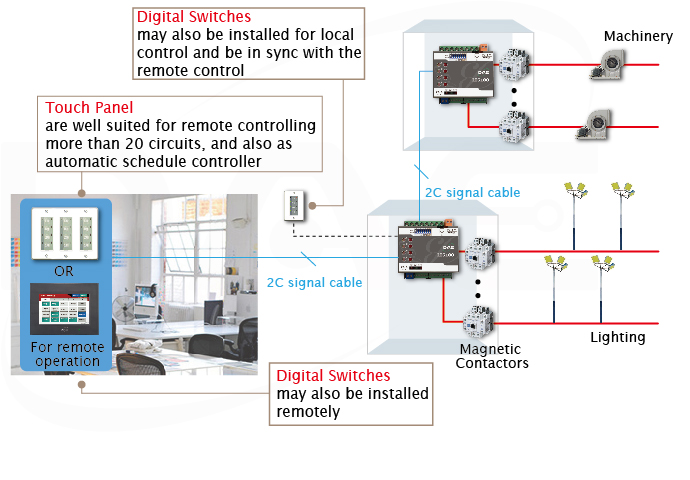Remote Lighting Control
Introduction
What the building manager needs is a system that is convenient and readily available to control the machinery that is spread out all over the building.

- The machine room is often placed in an obscure and remote location, but the building manager or operator is located in the office. If they need to operate the machines or monitor their status then they need to personally go to the equipment room.
- In a noisy and hot machine room, people don't want to go there unless absolutely necessary, don't even bother mentioning the danger of electrocution from the high voltages present.
- Having a remote interface is absolutely necessary not just for convenience but also for the sake of safety.
Traditional Shortcomings

Shortcomings of the traditional approach
- The control panel box out in the open is unsightly with its red and green buttons along with their indicator lights, and coming out the boxes are the conduits and cables, all of mar the beauty of any office no matter how attractively decorated it is.
- Any future expansion would be difficult, bothersome and disruptive.
- The typical way that the lights are controlled is with a one to one pairing between the lights and the switches that control it, which would require an 8 wire cable for complete control and status; 4 for the control and status from the panel box to the lights and another 4 from the panel box to the switches. With only 10 lighting circuits, that would already be 80 wires overall.
- With each floor and area having their own control panels, their numbers add up and the wiring installation plus labor costs may become quite prohibitive.
- If a timer is required, then the only way that this can be achieved is by attaching a timer to any single lighting circuit, with more circuits, the more timers are needed. Not only does this result in difficult and complicated installation, but changing the schedule is not an easy task either, which makes any impromptu change an even more challenging task.
Local Bus Solution

- A single controller may control up to 4 magnetic contactors or relays.
- To connect all the controllers together only a 2 wire signal cable is required to form a bus network.
- The 2 wire signal cable is sufficient to control up to 64 lighting circuits, all of which can now be controlled from a single touch panel or from a wall of aggregated digital switches.
- The operator can then set an automated control schedule by themselves, with separate time tracks for regular days and weekend.s
Online Solution

Centralized Control

There are two options for centralizing the controls:
- Exquisite digital switches
- Or the more attractive and power touch panel control interface (with schedule controls)
Digital Switches

- Easy to operate
- Economical and cost effective
- Suitable for use when the load circuits number less than 20 and there is no need for future expansions.
- Each button has its own status lights, and if needed each button can also be labeled.
- Can easily be wall or panel mounted, and occupies little space.
Touch Panel
- Available in English or Chinese languages, for ease of use.
- Large number of buttons organized neatly into pages for easy navigation.
- Update using a USB flashdrive for use when expanding the number of circuits supported, no need for additional hardware interface units as one only need to update the configuration on the existing touch panel.

- Control can be gathered and centralized through the touch panel, with basic scheduling capability.
- Unlike plain timers, the schedule can be easily understood and set directly from the touch screen, so simple to use that the facility manager can change it themselves and do so at any time.
- With separate time tracks for regular days and holidays.

Scheduler


- Set the schedule online
- Separate time tracks for regular days and weekends
- Each single circuit may have its own on and off times
- Displays the real time status of each circuit
- Each circuit can be given named labels
- Each circuit can be manually controlled to override the scheduled settings at any time.
